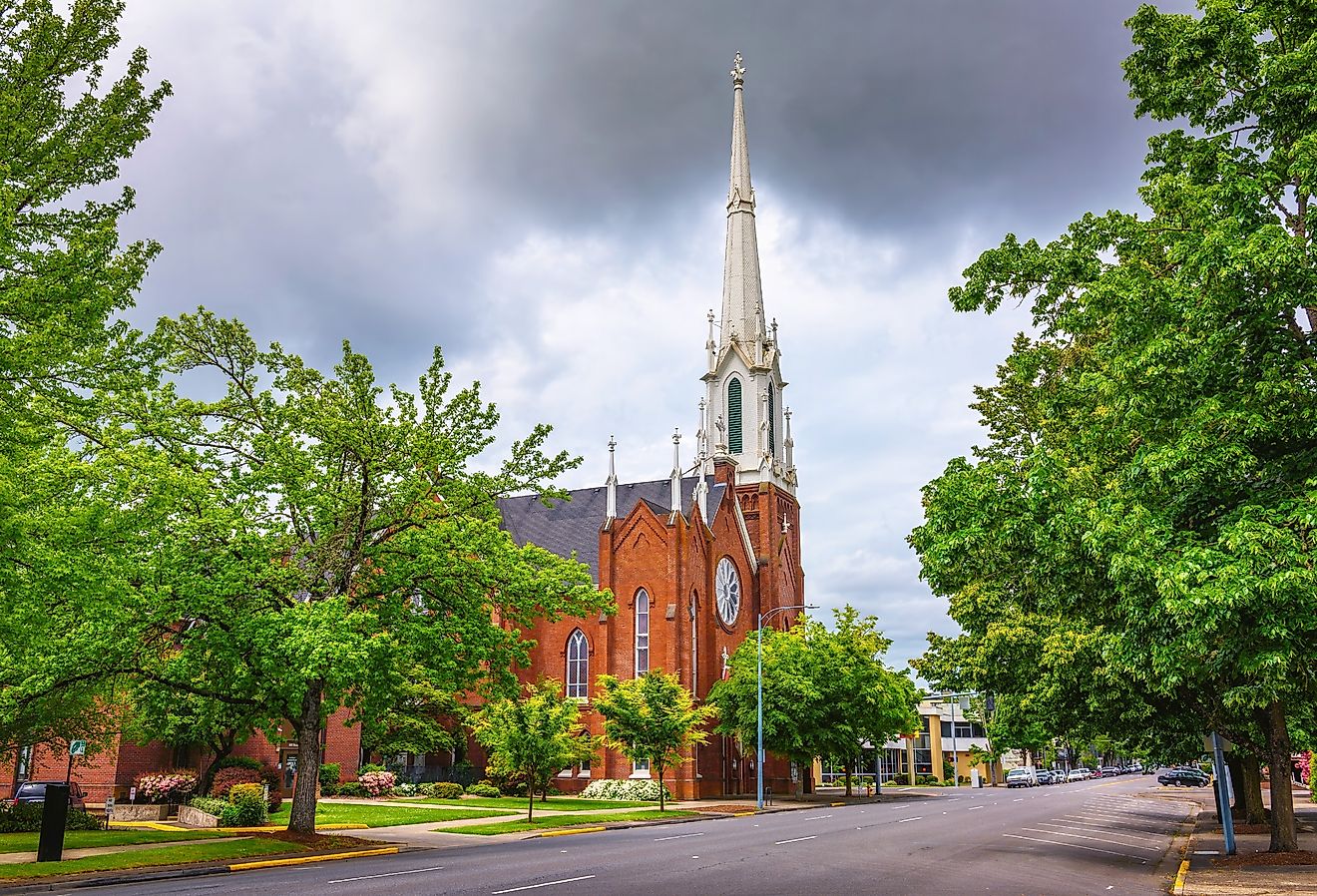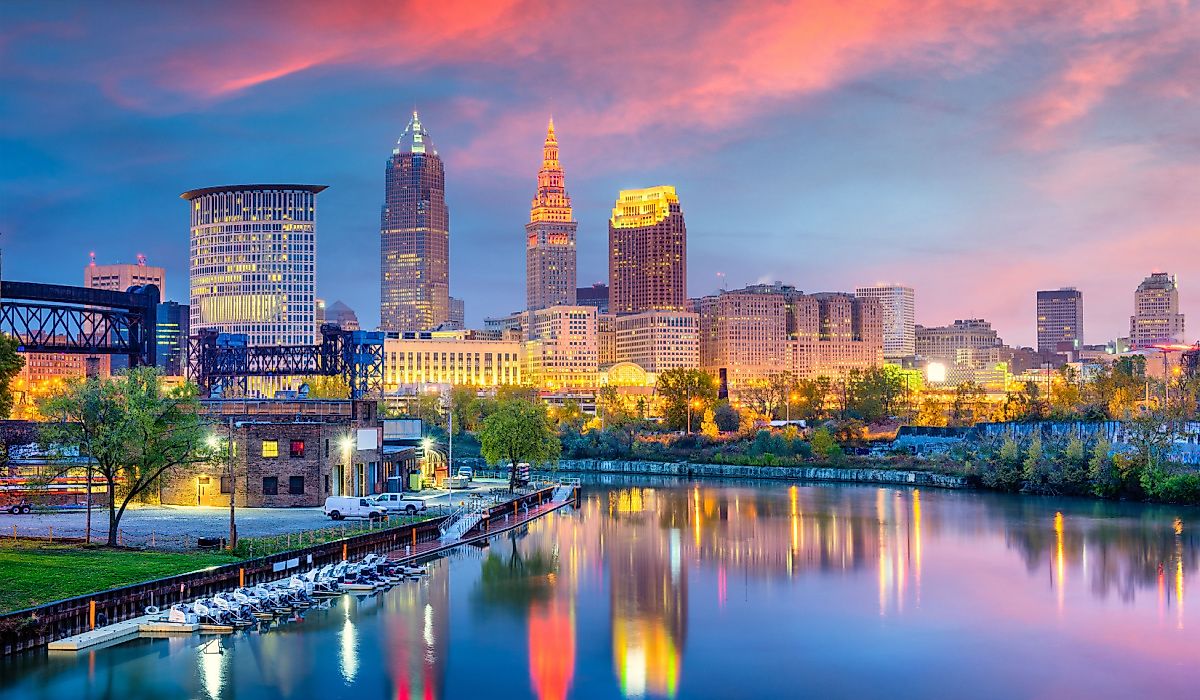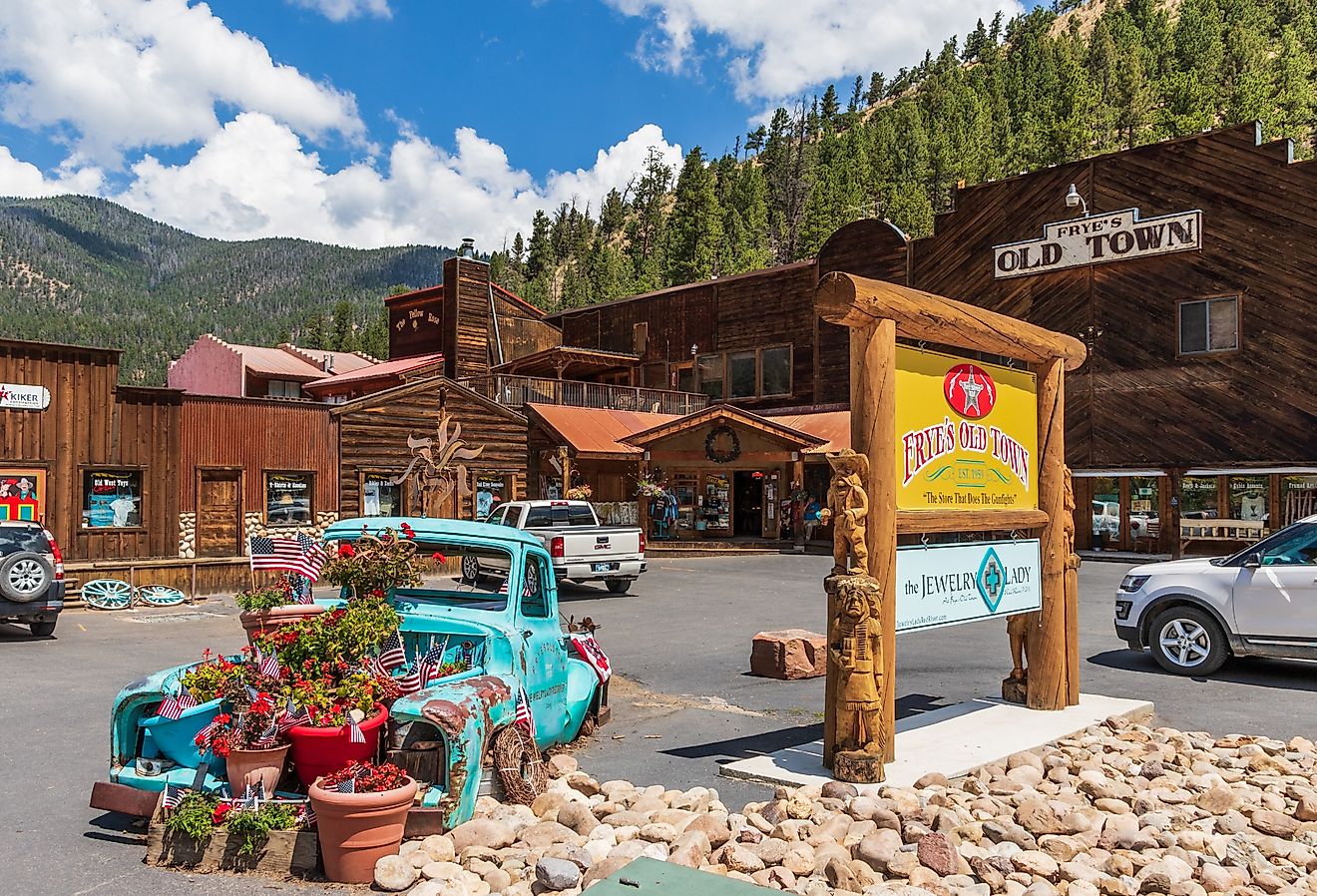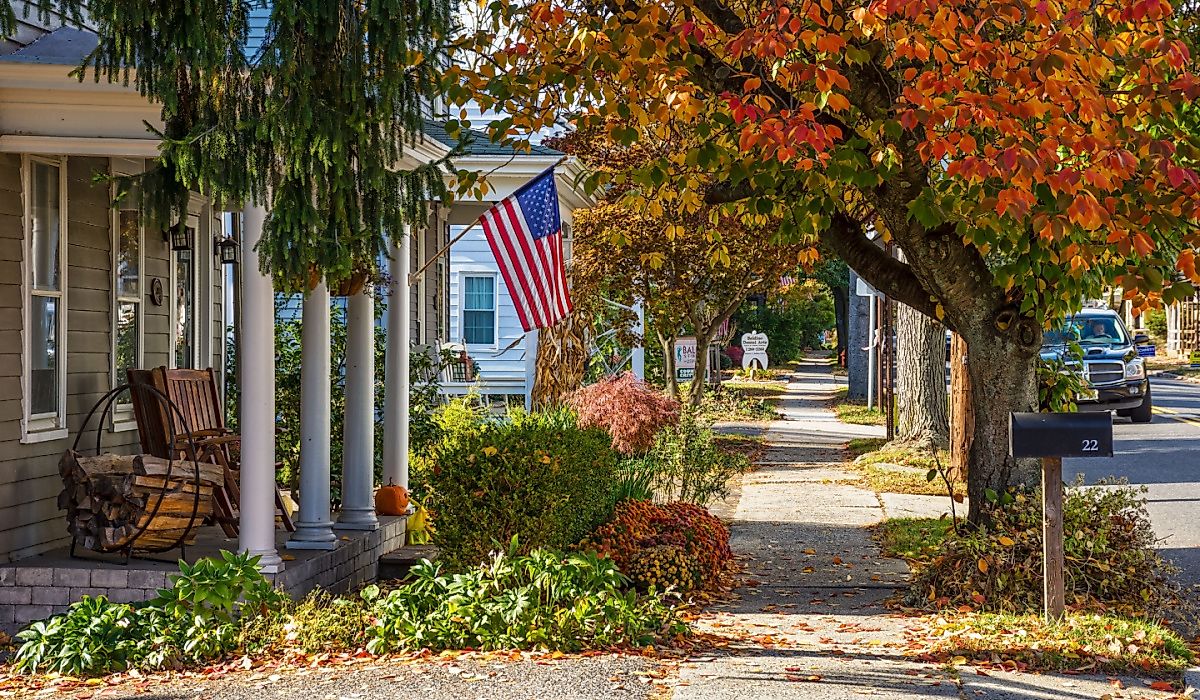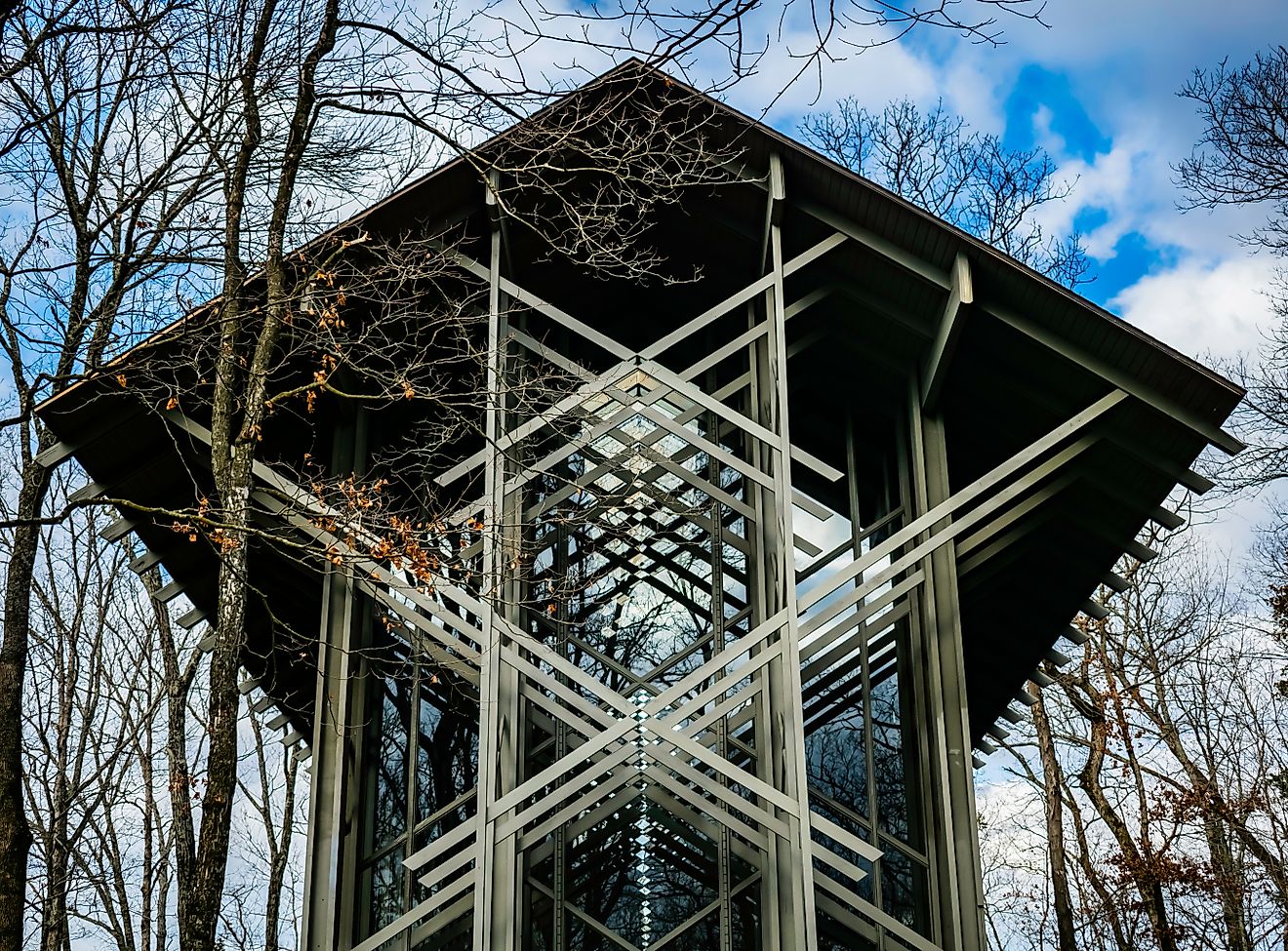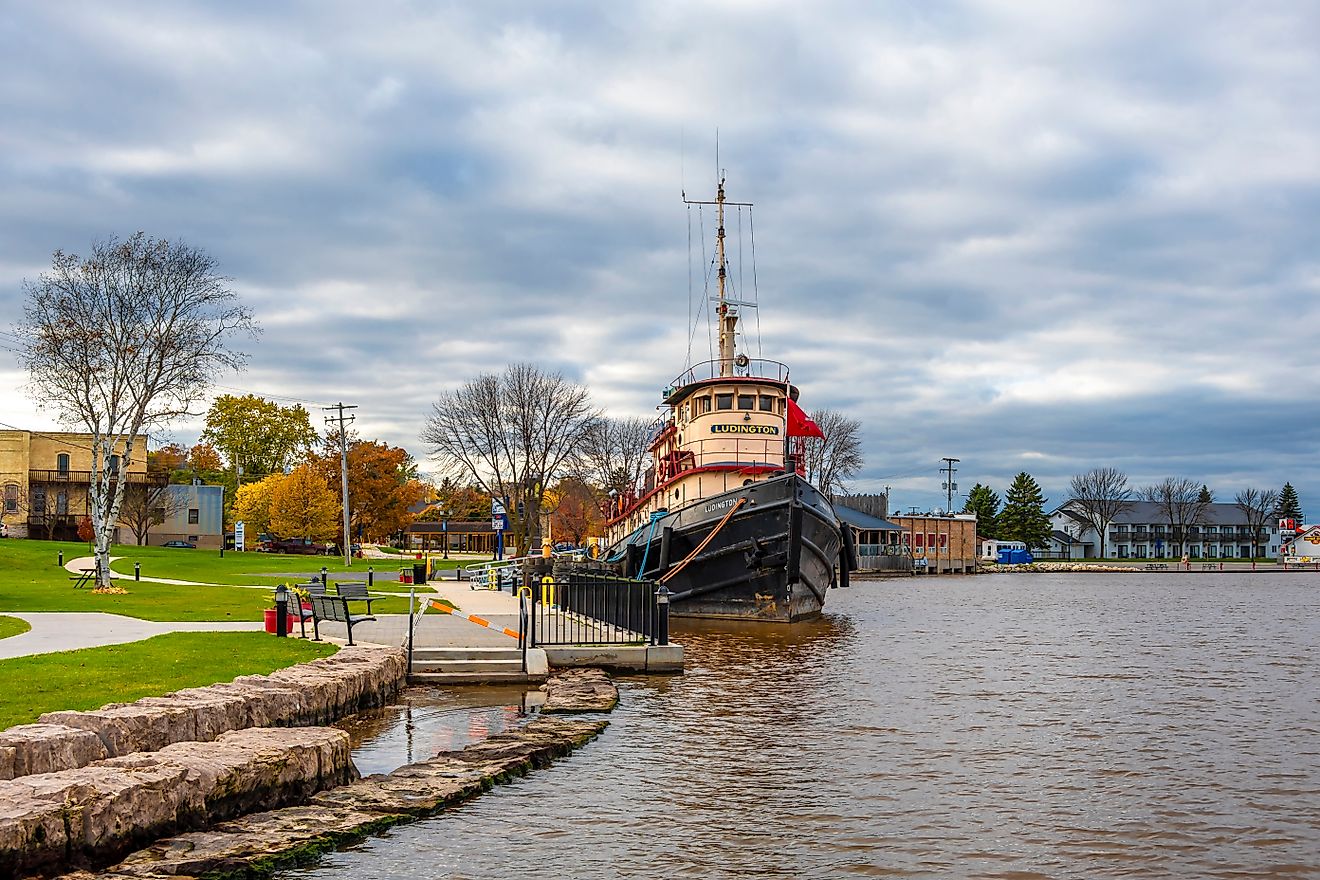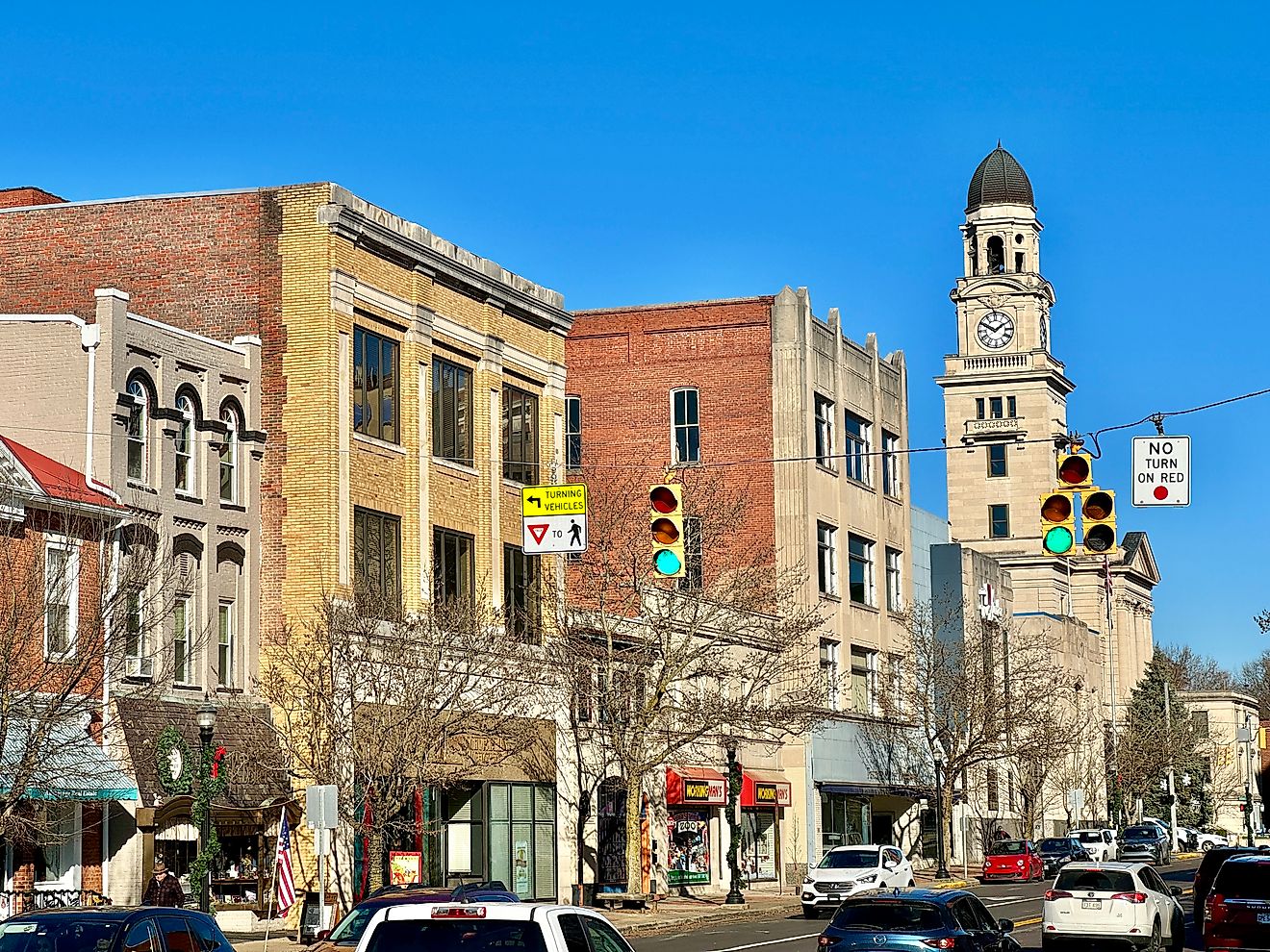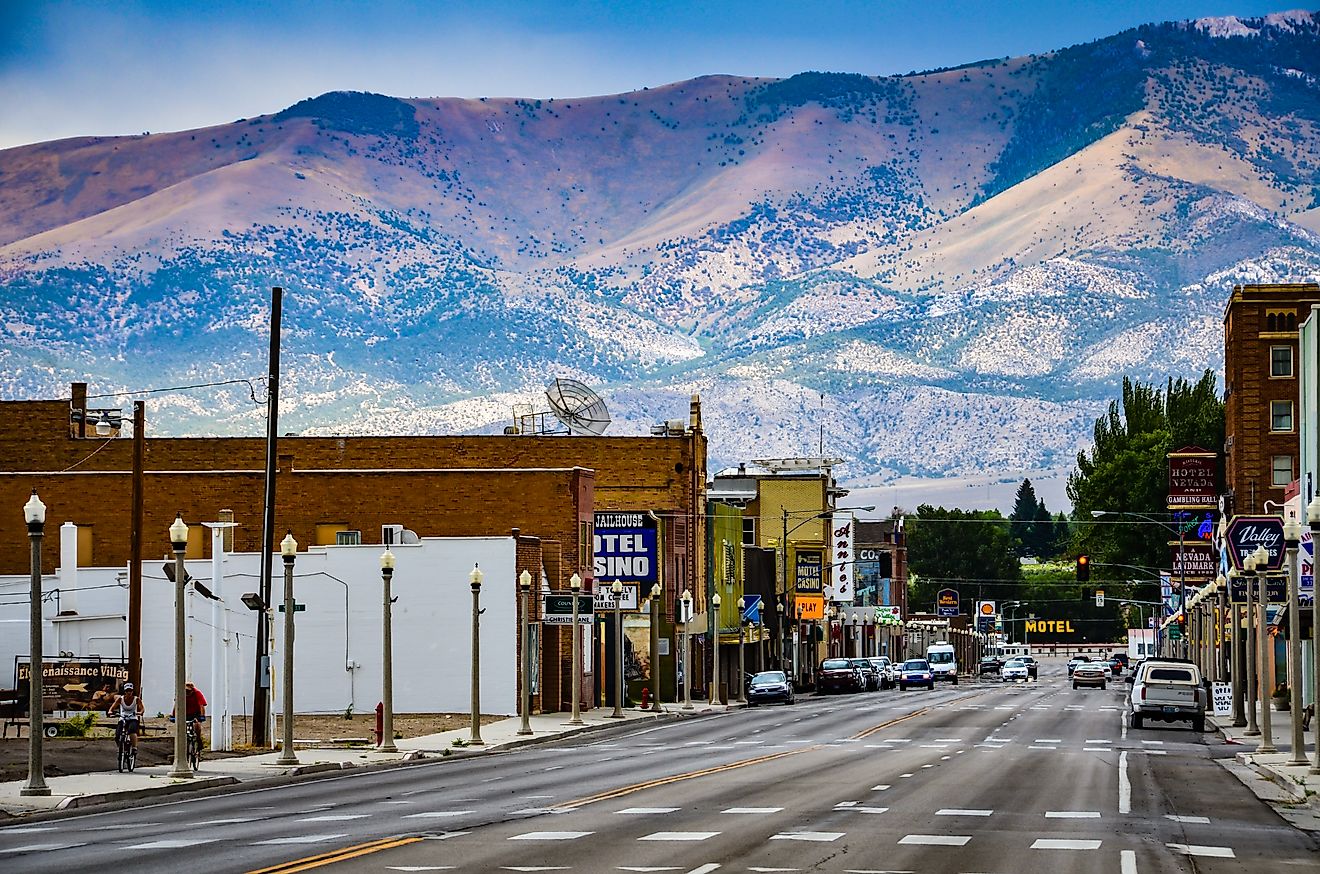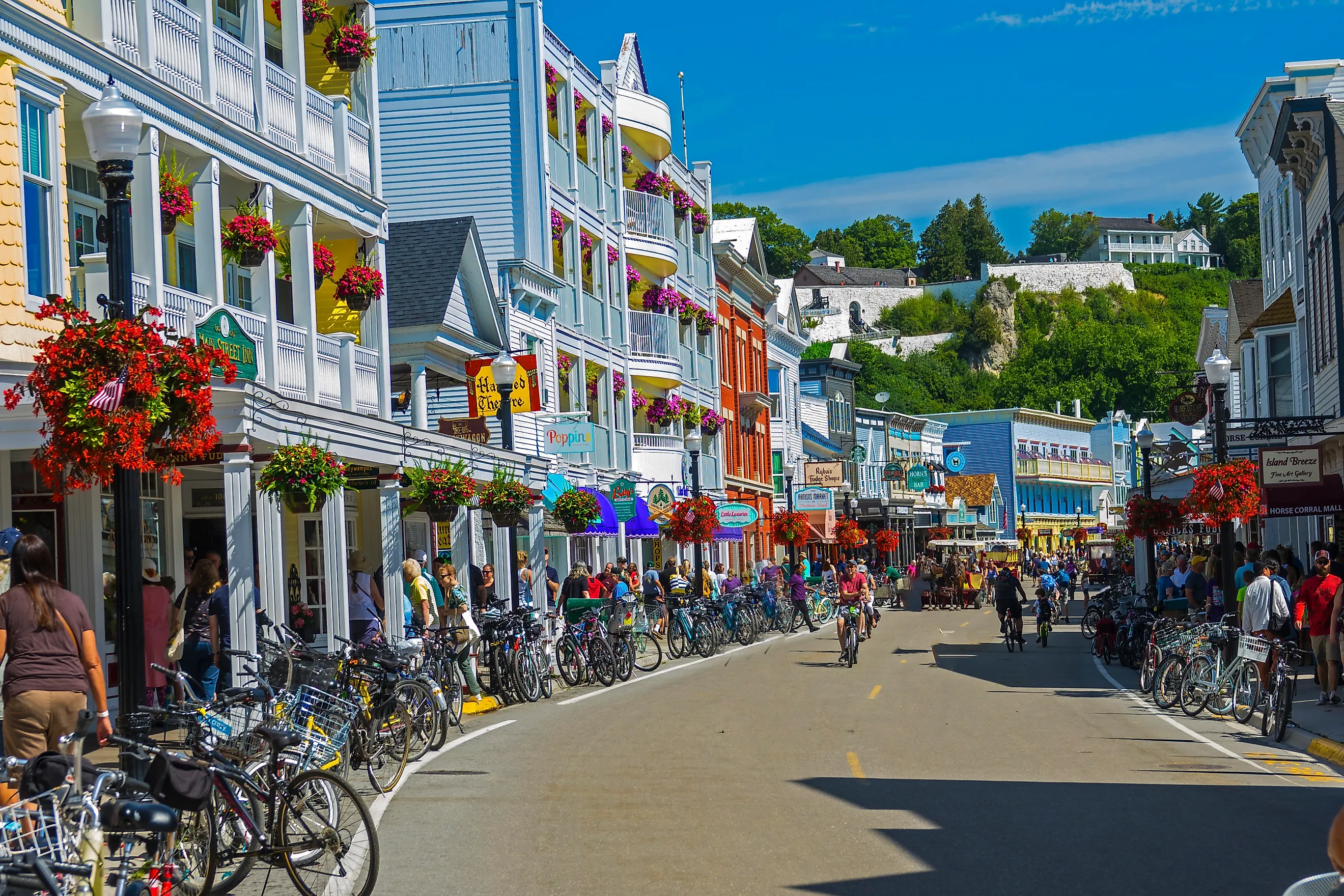
Mackinac Island
Floating at the precipice between Lake Huron and Lake Michigan, and at the hand-off between Michigan's Upper and Lower Peninsula, Mackinac Island is perfectly placed for a summer adventure. This historic, car-free enclave proudly preserves a timeless aesthetic while fully embracing the most exciting aspects of modern tourism. Here, on the "Jewel of the Great Lakes," a mix of horse-drawn carriages and bicycles roll past Victorian architecture, world-famous fudge shops, a massive hilltop fort, and cedar-lined limestone bluffs. Over 80% of this freshwater rock comprises Mackinac Island State Park, while the remaining fifth is dedicated to entertaining and satiating the boatloads of seasonal visitors. If you haven't had a chance to check out this fairytale destination or want to tap back into its magic for a moment, read on for a joyous overview of Mackinac Island.
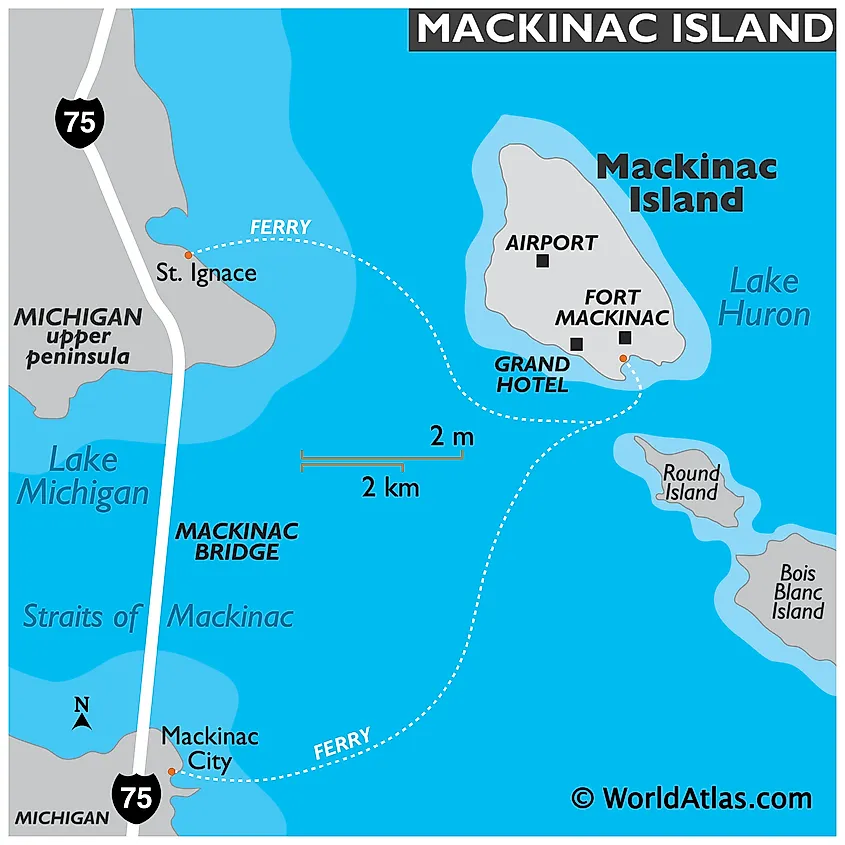
Geography

Mackinac Island (pronounced Mackin-aw, like the nearby city) is a 4.35 square-mile limestone formation that sits in the extreme northeast part of Lake Huron, just as it prepares to join the waters of Lake Michigan - two of North America's Great Lakes. As alluded to earlier, this is also the approximate latitude in which Michigan's Lower Peninsula gives way to the Upper Peninsula - a connection that is facilitated by the five-mile-long Mackinac Bridge (which can be clearly seen to the west from aboard the Mackinac Island ferries).
A whopping 82% of the island falls under the banner of Mackinac Island State Park. Even though no cars are permitted in this 1,800-acre preserve (as is the case with the rest of the island), an enormous network of roads and nature trails (144 miles in total) fans across its forested face. The island's developments are mostly clustered around Haldimand Bay (named after General Frederick Haldimand, governor of Canada in 1780). This is where the ferry's dock and eager passengers are set loose onto Main Street - both ends of which transition into the 8.2-mile-long Lake Shore Boulevard (M-185), which cleanly encircles Mackinac. Fun fact: this is the only state road on which cars are banned. Cyclists rejoice!
Getting to the Island

Two ferry companies offer services to/from Mackinac Island out of St. Ignace, Michigan (Upper Peninsula) and Mackinaw City, Michigan (Lower Peninsula). In either case, the voyage is short (i.e. approximately 20 minutes) scenic, and occurs regularly (so visitors can choose their own timelines). Anyone familiar with the Great Lakes Region knows that winters hit hard. As such, boat access is limited from late-April until October. During the off-season (or anytime throughout the year), visitors can utilize the Mackinac Island Airport - a 3,500-foot paved runway capable of accommodating propeller planes and small jets. Charter flights from St. Ignace take a mere four minutes. And best of all, horse-drawn carriages await to take passengers and their luggage onwards to the various island accommodations (everything from fancy hotels, to condo rentals, cozy cottages, and charming B&Bs).
Getting Around

Given that Mackinac Island is a car-free destination, the available methods of transportation are refreshingly archaic. Since the vast majority of visitors arrive at the docks of Haldimand Bay, carriages, bicycles, and good old-fashioned walking will be the three main choices. Personally, I think a casual meander is the best way to get familiarized with Main Street's amenities and the key historical structures. In fact, many of the primary attractions are located within one mile of the docks/Mackinac Island State Park Visitor Center.
With that said, if you come bearing luggage and simply want to get settled in before exploring, then there's nothing quite like a ride on a horse-drawn carriage to transport you back in time (en route to your destination). There are over 500 working horses on the island, so you won't have any problem hailing a ride.
Bicycles are another asset in abundant supply on Mackinac Island. Whichever dock you emerge on, look to your right, and look to your left, and you are bound to spot a rental shop. Various styles are available for slightly different hourly rates (depending on your adventure ambitions). I grabbed a single-speed for an hour, and was able to do a leisurely lap of Lake Shore Boulevard, stopping to take pictures and read the interpretive signs along the Native American Cultural History Trail in the process. For those interested in a longer tour, there are also plenty of interior pathways to deviate onto, including British Landing and Garrison Streets, which directly bisect the island (but be prepared for some sustained uphill riding).
Finally, avid hikers will be able to access the lesser-traveled nooks and crannies of the island. Along with the historic landmarks and winding, interconnected roads, there are also single-track nature trails that delve deeper into serene woods (try Tranquil Bluff Trail).
History
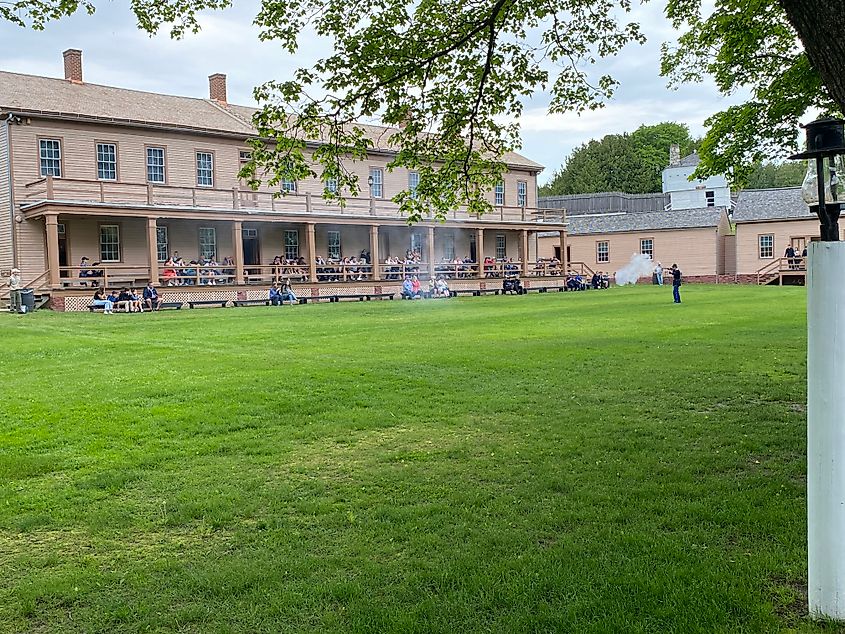
The earliest evidence of human activity on modern-day Mackinac Island dates back to 1,000 B.C. These semi-nomadic Indigenous people (also known as also the Great Lakes American Indians) paddled to the island each summer to fish for trout, pike, sturgeon, herring, and whitefish. Right at the end of the Woodland Period (i.e. 1000 B.C. to 1650 AD), the Anishinaabek people arrived at the Straits of Mackinac, giving Mackinac it's original name, Michilimackincac: meaning "Big Turtle," or "Island/Place of the Great Turtle." Twenty years later, the era of European settlement began with the establishment of a Christian mission on Mackinac Island.
Flash forward to 1779-1781: this is when the British dismantled Fort Michilimackinac (which had been built by the French near present-day Mackinaw City) and moved it to Mackinac Island in prescient preparation for an American attack towards the end of the American Revolution. Thus, Fort Mackinac was born, and would play a pivotal role in the island's subsequent history as it traded hands back and forth. During the War of 1812, the British once again took control (July 17th), and were decisive in their defeat of American troops during the famed Battle of Mackinac Island (Aug 4th, 1814), thanks, in part to an assist from their Indigenous allies. However, despite the victory, Fort Mackinac was later turned over to the United States after the signing of the Treaty of Ghent on December 24th of that same year.
The subsequent era of peace allowed for commercial exploits to unfold on Mackinac Island. In 1820, the American Fur Company was established. Over the next decade, millions of dollars worth of fur was counted, sorted, and shipped from this vital location. The same infrastructure that facilitated the fur trade proved equally valuable during the fishing boom of the 1830s. Thanks to the growing populations (and therefore, appetites) of nearby Chicago, Detroit, Cleveland, and Buffalo, commercial fishing became the island's primary industry.
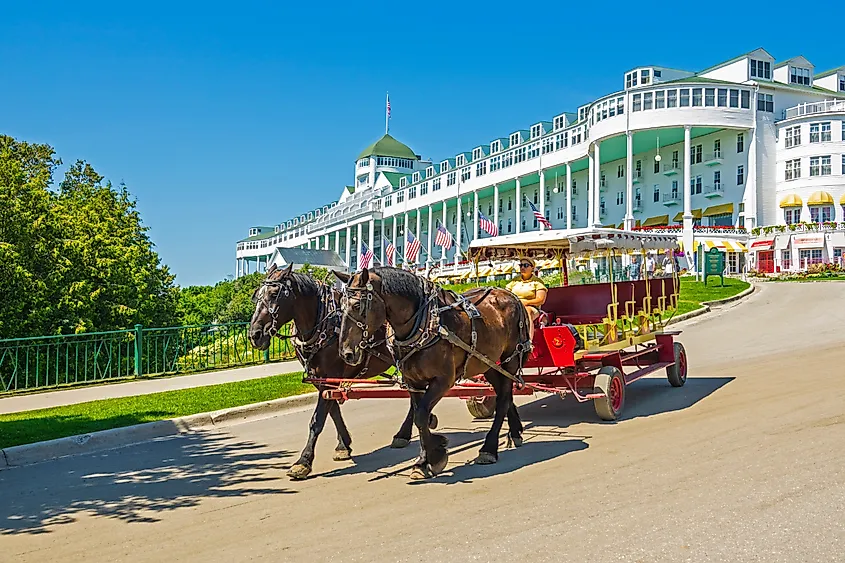
In response to the wave of post-Civil-War tourism, the Federal Government created Mackinac National Park in 1875 - just three years after Yellowstone's inception - thereby making it America's second national park. The further escalation of enthusiastic visitors spurred the building of the Grand Hotel in 1887. With its palatial physique and 660-foot porch (i.e. the "World's Longest Front Porch"), the National Historic Landmark cemented Mackinac's reputation as the most desireable summer resort in the Great Lakes Region. Another fun fact: In keeping with the timeless aesthetic, gentlemen visiting the Grand Hotel are still required to wear a jacket and tie to dinner. With each passing summer, humble cottages, mansions, and eventually modern condos all sprouted. There are now over 1,600 guest rooms for visitors to choose from.
Two years after the Grand Hotel opened, another cherished (and still surviving) attraction arrived: Murdick's Fudge. This "candy kitchen" paved the road for the dozen sweet shops that would follow suit. Nowadays, thousands of pounds of Mackinac Island's world-famous fudge are served up each summer.
In 1895, with war well in the rear-view and jovial summers the norm, the Federal Government decided to remove its soldiers from Fort Mackinac and transfer ownership to the state of MIchigan. Hence, Mackinac Island National Park became Mackinac Island State Park. Three years later, the Village of Mackinac Island banned the use of "horseless carriages" after complaints about the noise and potential dangers they brought. Three years after that, cars were also banned from the state park, meaning that locomotion across the entire island was to be solely horse and human-powered from thereon out.
Mackinac Island's prosperity, as was the case for much of the country, dwindled in the face of the Great Depression and outbreak of World War II. Thankfully, it did rebound soon after and come October of 1960, the whole island (and Haldimand Bay) was listed as a National Historic Landmark. These days, an estimated one-million people visit each year.
Attractions
Mackinac Island's attractions are extensive - far more than can be fully appreciated with a single trip. The restaurants, cafes, and souvenir shops along Main Street could fill an entire summer, let alone the attention that the iconic fort, informative museums, legendary landmarks, hidden trails, and terrestrial and aquatic tours all demand. Here is a snapshot of some of the classic attractions.
Downtown
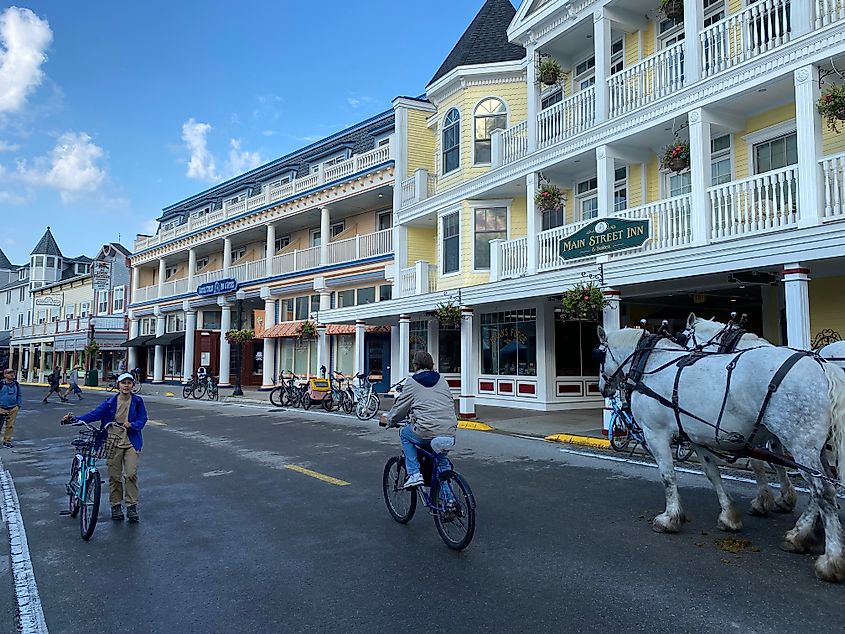
Step off the ferry and into the fantasy world that is downtown Mackinac Island. The several square blocks between Main and Market Street are packed with stylish accommodations and shopping/dining outlets - not to mention the hoards of pedestrians, cyclists, and horses (so be mindful of oncoming "traffic" as you gaze about in wonder). I started my adventure with a coffee at Lucky Bean Coffee House, and signed off with a pre-departure pint at Great Turtle Brewery & Distillery.
Mackinac Island State Park
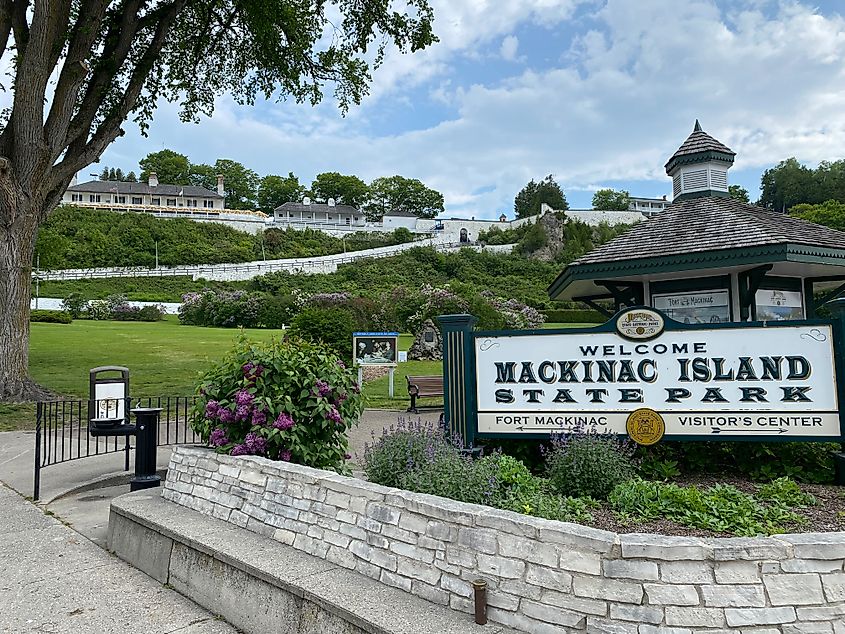
Main Street naturally flows toward the Mackinac Island State Park Visitor Center at the base of Marquette Park and Fort Mackinac. Though the state park is free of charge, this is still a great place to get one's bearings, learn about the area, form a plan of attack, and buy tickets for the fort (which also includes entry into other museums). From here, the world is your oyster, and should be tackled according to physical ability and preference. Anyone seeking a classic, nature-immersed state park experience will be rewarded for venturing deeper into the island.
Fort Mackinac
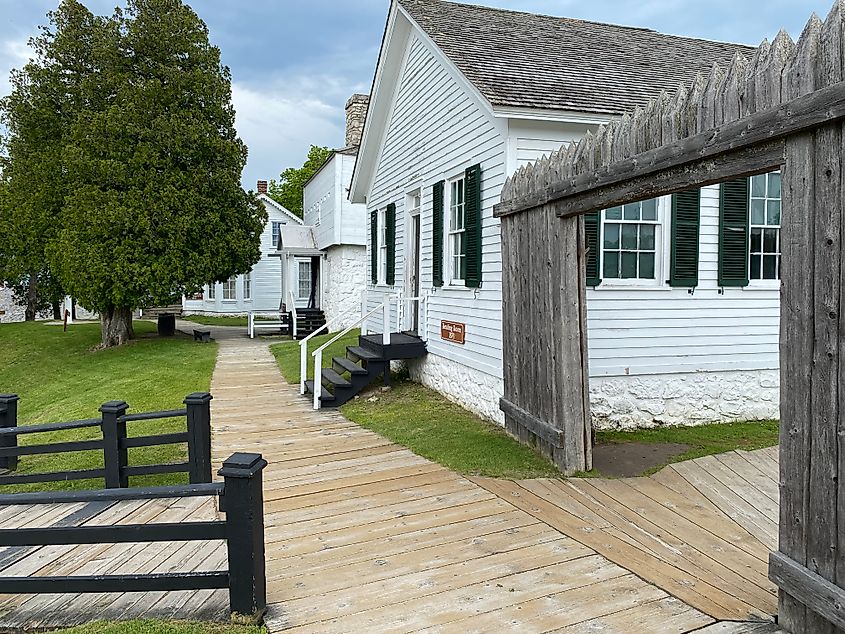
From the visitor center, a hefty hill separates tourists from the next major attraction: Fort Mackinac. Within its 244-year-old walls, there are 14 restored buildings (which are open from early-May until late-October), a diverse array of exhibits, and even regular cannon and rifle demonstrations performed by the authentically-clad scouts. Even those disinterested in history will get a kick out of the sweeping panoramic views offered by several of the fort's lookout points and restaurant patio.
Museums

Keep your Fort Mackinac ticket on hand, as it will also grant you access (from early-June until mid-August) to The Richard & Jane Manoogian Mackinac Art Museum, Biddle House/Mackinac Island Native American Museum, and Benjamin Blacksmith Shop. If these blasts from the past catch your fancy, consider continuing on to the Antique Bicycle and Motorboat Museum (at Ferry Dock #1), the Grand Hotel Horse Carriage Museum (a working facility that's home to the estate's 12 resident horses and 20 antique carriages), The Horse In History Museum (inside Mackinac Equestrian Center), the Images of Faith Museum (inside the Ste. Anne Church), the Mackinac Arts Council Gallery, and the Stuart House Museum (i.e. the 1817 headquarters of John Jacob Astor's Fur Trading Company).
Outdoor Exploration

Arch Rock stands 146 feet above the water and spans 50 feet at its widest. Geologists explain the crowd-drawing formation as a result of wind/water erosion, whereas local Native American legends cite a tragic love story in which a woman is tied to the mountain by her father as punishment for falling in love with the son of a sky spirit. Broken-hearted, she wept until her tears wore away at the rock below. Whatever the case, it remains one of the island's most recognizable natural formations. It can be visited by continuing northeast of Fort Mackinac, or seen from Lake Shore Boulevard below (another great reason to rent a bike). The other standout geological feature to aim for is Sugar Loaf Rock - a 75-foot-tall limestone stack located just a short walk from Arch Rock (i.e. at the end of Sugar Loaf Road). Lastly, one of Mackinac Island's best natural attractions is its sunrises and sunsets. Push yourself to get up the hill for the book ends of the day and you'll be treated to dawn breaking over Lake Huron, or dusk descending upon Lake Michigan.
In terms of outdoor recreation, Mackinac Island is clearly a cyclist's paradise. But this unique rock also hosts four annual running events, and boasts two golf courses, a short-game facility, and a mini-putt venue.
Mackinac Arts Council Summer Series
Quite a lot of culture can be enjoyed during the peak season. The Mackinac Arts Council's Summer Series includes Music in the Park (every Thursdays at Marquette Park), a Performing Arts Series (each Sunday at various locations), Movies on Mackinac (at the Mission Point Theatre) and Mackinac Island Art Exhibits (which occur daily at The Center for the Arts inside the Mission Point Resort).
Final Thoughts
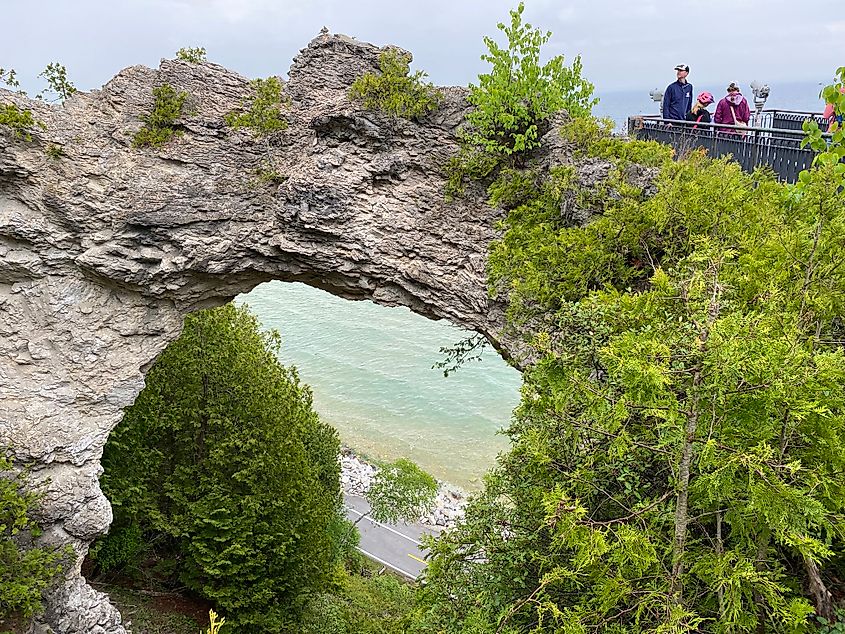
I didn't know what to expect when I first set foot on Mackinac Island. Sure, I had seen beautiful pictures and read about its charming, old-fashioned ways, but the real-life experience still blew all of that out of the water. Mackinac Island has something for everyone. It can be energetic and endlessly entertaining, it can be introspective and informative, or it can provide the opportunity to delve deep into the natural side of The Great Lake State. In retrospect, I wish I had allocated more than just a day of exploration, but now I know to pencil in an extended return trip as soon as possible. Until next time, Mackinac Island.

